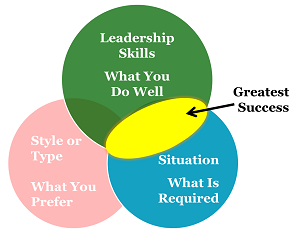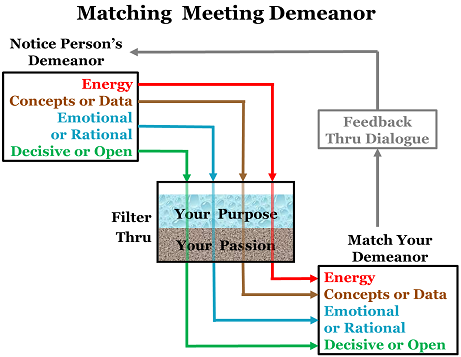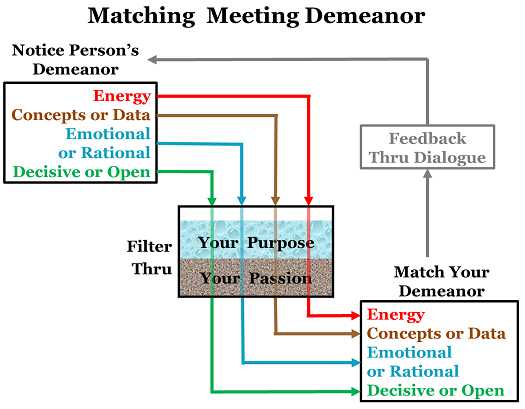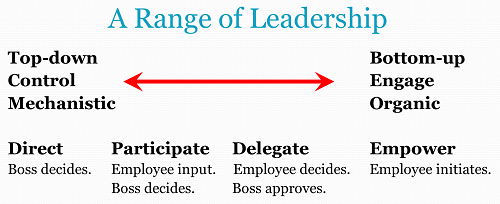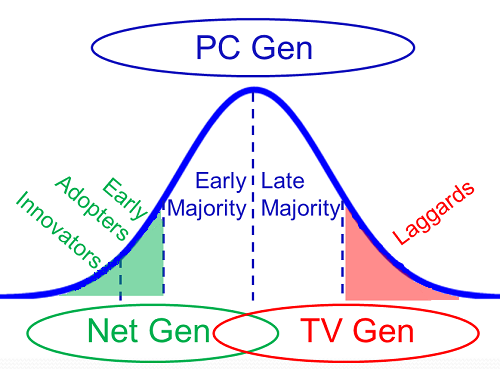When you walk in the room, who shows up for Read more →

Styles & Types? Or Situations & Tools?
Allen Slade
In my experience, the leader’s toolbox is a powerful way to think about your leadership. But some people push back, especially fans of leadership styles or personality types.
Styles and Types
Some leadership advice focuses on changing leaders to be the right style. Be more participative or be more communicative. Be a Theory Y leader. Be a 9,9 leader. Unless you luck into the right situation where this style is always best, one-best-style leadership advice should be avoided.
A somewhat better form of leadership advice is to “find your leadership style” so you understand how you work best. A strategic leader might want to complete and complement her leadership style by hiring a detail oriented manager. Closely related is “find your type” advice using a personality test or the Myers Briggs Type Indicator. If you know your personality type, then you can find situations that fit your personality. Introverts can work on solo analytical projects, while extraverts should find jobs with lots of personal contact.
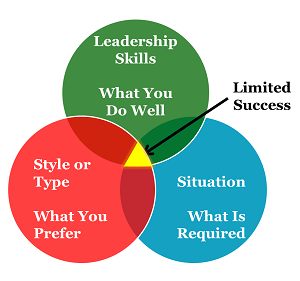 Taken to the extreme, “find your style” or “find your type” leadership limits your success as a leader. Your sweet spot as a leader will be the narrow intersection of skill, style and situation. If your style limits your range of leadership, your success will also be limited.
Taken to the extreme, “find your style” or “find your type” leadership limits your success as a leader. Your sweet spot as a leader will be the narrow intersection of skill, style and situation. If your style limits your range of leadership, your success will also be limited.
Restricting yourself to one preferred leadership style or personality type is like restricting your driving to only certain roads. If you can drive on more roads, you will go further.
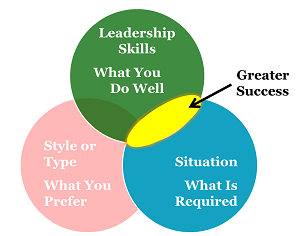 If you take your prefered leadership style or personality type out of the picture, you expand your sweet spot. You can lead in more ways and you will have greater success as a leader.
If you take your prefered leadership style or personality type out of the picture, you expand your sweet spot. You can lead in more ways and you will have greater success as a leader.
For example, my personality is strongly introverted. Yet, to be successful as a consultant, an HR executive and a professor, I stopped acting like an introvert. I developed my public speaking skills. I focused on networking even when I wanted to curl up with a good book. I don’t use my personality as an excuse. If my leadership does not serve me well in a given situation, I try another harder or switch leadership tools.
Situations and Tools
The leader’s toolbox approach expands your choices as a leader:
1. Fill your toolbox with a variety of leadership tools for relationships (communication skills, meeting demeanor, decision making techniques, confidence and emotional intelligence) and tasks (budgeting, scheduling, goal setting, execution and quantitative skills).
2. Pick out the right tool for the situation.
3. Get feedback and adjust as necessary.
Bottom line: To be fully effective as a leader, you must be flexible in your own behavior. A lack of adaptability fundamentally limits you as a leader. You cannot rest on a certain leadership style or preferred type of interaction. You should fill your toolbox with a wide range of leadership skills and be flexible in when you use which tool. You will increase the sweet spot of your leadership and reach your greatest success as a leader.
Leadership Tools: Purpose and Passion, Feedback and Subtlety
Allen Slade
The most effective leaders adapt to the situation, but they are driven by their own purpose and passion. You can stumble by being inflexible. You can stumble if circumstances drive you. The best leader will balance openness to feedback with constancy of purpose.
How do you balance adaptability with purpose and passion? One example is the leadership tool of matching meeting demeanor.
As you match the four aspects of meeting demeanor (energy, concepts or data, emotional or rational persuasion, decisive or open-ended), you need purpose and passion, feedback and subtlety.
Purpose and Passion
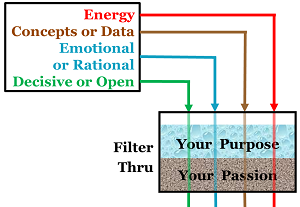 As a leader, your purpose sets your direction. Your passion energizes your actions. Your purpose and passion should filter everything you do, including your meeting demeanor.
As a leader, your purpose sets your direction. Your passion energizes your actions. Your purpose and passion should filter everything you do, including your meeting demeanor.
In a meeting at Microsoft, a vice president, my boss and I were synced up on meeting demeanor. We had medium energy and we were looking at concepts, rationally and decisively. Then, we discussed “what would happen if” we were asked to violate employee confidentiality. Because of my passion for confidentiality, I immediately switched demeanor. I went high energy and made an emotional argument. In other words, I threatened to quit. The meeting quickly broke up, my boss high-tailed it down the hall and I was left standing outside the VP’s office.
The VP apologized the next morning, and I was never asked to compromise my standards. But, even if I had lost my job over this outburst, my passion for confidentiality is so strong that I would have been content with my actions.
Feedback
Leaders have to balance constancy of purpose with openness to feedback. To be effective, you need feedback on your impact.
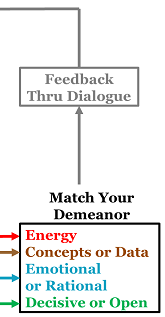 If you have no awareness of others’ meeting demeanor, you will usually not be very effective. If you take a quick snapshot of energy, data vs. concepts etc., at the beginning of the meeting, you will be more effective.
If you have no awareness of others’ meeting demeanor, you will usually not be very effective. If you take a quick snapshot of energy, data vs. concepts etc., at the beginning of the meeting, you will be more effective.
But, just like video is richer than still photos, you want to have continuous feedback on your meeting impact. Watch their body language, voice tone, and what they say to see if you are truly matching up your demeanor.
Match, Don’t Mimic
The wise leader will adjust meeting demeanor directionally to fit the demeanor of others, but not to excess. I suggest matching at a level of 80% to 120%.
- If the other person has much higher energy than you, adjust your energy to 80% of theirs. If they are much lower energy, adjust your energy to 120% of their energy.
- If they are all about concepts, don’t skip the data slides in your presentation. Just touch them lightly and move on.
- If they are absolutely decisive, match their drive to decide, but reserve the right to request a future meeting to follow up on the issue. If you request followup decisively, they are likely to say yes.
Bottom line: Your impact is magnified by matching the meeting demeanor of others in the room. Filter your actions through your purpose and passion. Get instant feedback by observing how your demeanor is impacting the others. And be subtle – match demeanor, don’t just mimic behavior. Then, your meeting influence will grow as the people around you respect your adaptable leadership.
Leadership Tools: Matching Meeting Demeanor
Allen Slade
Leaders need a toolbox full of tools for task leadership (budgeting, scheduling, goal setting, task execution) and relationship building(communication, decision making techniques, empathy). To use these leadership tools well, you need to diagnose the situation before you pick your tool.
A coaching client asked me “How should I act?” in an important meeting. I suggested matching his confidence to his competence and matching his demeanor to the other person. Let’s look at how “demeanor matching” works.
Often, leaders are called upon to persuade someone to take action. You might be planning with your boss, problem solving with an employee, trying to close a sale or interviewing for a job. It’s important to focus on the content of the meeting, but your influence will be determined by the tone of the meeting. How do you get your demeanor right?
Consider four dimension of meeting demeanor:
- High energy vs. low energy.
- Concrete data vs. abstract concepts.
- Rational persuasion vs. emotional persuasion.
- Decisive choices vs. option multiplying.
If two people are badly mismatched on any of these dimensions, the meeting will not go well.
We have all been held hostage in meetings. The other person is not on your wavelength and they are clueless about their lack of influence. They are high energy while you are drifting off. Maybe they offer abstract concepts when you need hard data. Or they make an emotional appeal when you want a rational argument. They push for decisive action when you want to keep your options open.
To avoid holding others hostage in a pointless meeting, don’t be tone deaf. Start by noticing the other person’s demeanor, then decide how your meeting demeanor needs to adjust.
Energy. If they have little energy for this topic, don’t try to bulldoze them. Take a low key approach. Pause, contemplate, listen even more than usual. But if they have high energy, ramp up your excitement to match.
If your purpose is to pursuade them, you may have to go against your native personality. Extroverts may have to calm down. Introverts may need to get fired up.
Concepts/data. If their conversation centers around concepts, principles, precedents, fairness – respond in kind. If they ask for data, proof, evidence, case studies, give them the numbers and facts they need.
Once again, you may be more conceptual or more data oriented, but don’t let that undermine your effectiveness if the other person is on a different wavelength.
Emotional arguments or rational arguments. Listen and observe. If they say or act in a way that suggests they want to approach this topic through an emotional lens, paint your argument with the colors of feeling. If they want to argue, respond with logic.
The “emotional intelligence” industry is built on the failings of leaders who think it is irrational to be emotional. You can also fail with feelings when the other person wants logic. Either way, if your purpose is to persuade, you may have to step outside your native logic to match their meeting demeanor.
Decisive or open. Sometimes, the other person wants to decide now. Other times, they want more options, more evidence or more people involved.
If you are naturally decisive but they want more time, you may need to practice patience. If you tend to keep your options open but the other person expresses impatience, you may need to work toward a “best guess” decision.
Bottom line: Effective leaders are versatile in their meeting demeanor. They use high energy or calmness, concepts or data, feelings or logic, decisiveness or patience, as needed to fulfill their purpose in the meeting.
In your next meeting, try noticing the demeanor of the other person. Then notice your own demeanor. Adjust as needed to be at your most influential.
Leadership Tools: Confidence
Allen Slade
Effective leadership requires adaptability. Leaders should fill their leadership toolbox and then pick the right tool for the situation. In other words, match your behavior to the task at hand.
Last week, a coaching client preparing for a one-on-one meeting asked “How should I act?” Because principles of leadership are outdated, I didn’t give a one-size fits all answer. Instead, I suggested two ways to match his behavior to the situation: Match your confidence to your competence (today’s topic). Your demeanor should match the other person’s demeanor (in the next post).
As a leader, your confidence is a tool. You should be able to influence others based on your experience, your expertise or your position of authority. But like any tool, you can misuse your confidence.
Overconfidence is a common leadership failing. If you choose to act confident, make sure you have the competence to back it up. If all you own is a hammer, everything looks like a nail. If your leadership “style” is always high confidence, you will hammer decisions and people. Don’t be that leader.
Lack of confidence is another leadership failing. If you act like you do not know, you will undermine your leadership. If you don’t act like a confident leader, no one will want to follow you.
Even moderate confidence has drawbacks. “Powerful but approachable” or “humble yet decisive” may be desirable blends, but there are times when very high confidence (or very high humility) would be better than a compromise.
Sticking with one level of confidence – high, low or in between – would be leading on cruise control. Instead, match your confidence to your competence.
Suppose you face a high stakes technical decision. How can you match your confidence to your competence?
If you are a novice in the technology, listen and learn. Ironically, you can build credibility by complying with others. Save your confidence for situations where you know what you are talking about.
If you know about as much as the others in the room, engage in a good give and take. Bring your competence to bear, but don’t be overbearing. Admit the limits of your expertise and experience. Value the competence of others.
If you are highly competent to deal with this issue, you can show analytical strength and make hard-hitting recommendations. But even as the most competent person in the room, treat your confidence as a tool rather than a trait. At times, put confidence back in the toolbox to pull out other tools like listening or consensus building.
Bottom line: Treat confidence like a tool rather than a trait. Match your confidence to the situation to maxmize your credibility and influence.
Using the Tools of Leadership
Allen Slade
As a leader, it is not enough to have the job title. At the point of action, you need to choose the right tool for the job.
Leaders can’t operate on cruise control. Instead, they should will fill their leadership toolbox with a variety of tools: Task and person leadership. A variety of communication techniques. A range of decision making approaches. Verbal, quantitative and emotional intelligence. Macro and micro perspective. Fast or slow action. Problem solving and paradox managing.
 But you can mess up, even with a full toolbox. At the point of choice, you need to know which leadership tool to pick up. If you pick up a circular saw to cut hard to reach nails, don’t expect it to go well.
But you can mess up, even with a full toolbox. At the point of choice, you need to know which leadership tool to pick up. If you pick up a circular saw to cut hard to reach nails, don’t expect it to go well.
There is no simple how-to guide for leadership. While Amazon lists 86,941 books on leadership (and probably more by the time you read this post), be careful. The reality you face is more complex and subtle than obeying leadership laws or imitating newsworthy leaders.
Bottom line: You need to develop your own leadership insight through experience and the wisdom of others.
Leadership insight starts with personal experience. As you develop the ability to use a leadership tool, you will start to develop a sense of when that tool is the best choice. Maximize your growth by taking an intelligent change approach to your leadership experience.
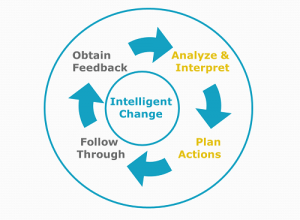 Risk-taking. Leadership insight starts with action – what’s called follow through in our intelligent change model. Excessive perfectionism will keep your shiny new tool in the box.
Risk-taking. Leadership insight starts with action – what’s called follow through in our intelligent change model. Excessive perfectionism will keep your shiny new tool in the box.
Feedback. Experience-based learning happens only with feedback. You need to know how the tool worked to know when to use it.
Reflection. It is not enough to experiment and to collect feedback. You must analyze and interpret your experience. Contemplating the what, how and (especially) the when of your successes and failures will help you figure out when to choose a leadership tool. To be accountable for reflecting on your leadership, try keeping a leadership journal or chat with your circle of trusted advisers on a regular basis.
The wisdom of others. You learn faster with help. Teachers, mentors and coaches are all valuable resources to help you figure out your personal theory of leadership. As leaders mature, they learn less from the expertise of teachers or the experience of mentors. From mid-career on, leadership growth requires finding your own leadership coach or executive coach. Ask your senior leader or HR person if your company can provide a coach for you.
Fill your leadership toolbox and develop your insight so you know what works. Then, you will be ready to grab the right tool for the situation.
The Leader’s Toolbox
Allen Slade
Before rebuilding our friends’ deck, I loaded my van with tools: 3 power saws, 4 drills, 3 measuring squares and a bucket full of hand tools. Why so many tools? Wouldn’t one saw be enough? The circular saw cuts fast and straight, but isn’t maneuverable. The sabre saw cuts straight or curved, but slow. The reciprocating saw is for demolition – maneuverable but leaves a jagged cut. The third measuring square was unnecessary, but every other tool was used repeatedly.
In Leading on Cruise Control, I suggested that the best leaders adjust to the conditions they face. As a leader, you need a variety of leadership tools and the ability to diagnose what tool is needed for the situation at hand. But tools come before diagnostic skill. If all you own is a hammer, then everything looks like a nail. Here is a partial list of tools that should be in every leader’s toolbox.
Task and Person Leadership. The ability to focus on task leadership – resource allocation, project management, goal setting and execution. And, the ability to build strong and mutually beneficial relationships.
Communication. One-on-one, small group and large group. Rhetorical persuasion, information sharing, story telling and listening. Requests, offers, negotiations, declarations and assessments. Management by walking around and the ability to influence from a distance.
Decision Making. Data-driven or political decisions. Optimizing or satisficing. The full range of employee involvement – Direction, participation, delegation or empowerment.
Fast and Slow. Strategic thinking and instinctive reaction. The ability to do exhaustive, multi-disciplinary long-range planning and the ability to leap before you look.
Intelligence. Verbal, quantitative and emotional intelligence. The ability to see the big picture and to edit the pixels. The ability to solve problems and to manage paradoxes. Principled moderation.
How do you add tools? Start treating every day as a leadership laboratory. Do many mini-experiements and get lots of feedback. Take every opportunity to try the new and different. Communicate differently – new groups, new approaches, new technology. Take every class you can.
Longer term, take on big challenges. Get another degree. Take on stretch assignments. Switch functions. Switch careers. Cross cultures.
 For an emerging leader, this list can be overwhelming. Be patient. It takes time to fill your toolbox.
For an emerging leader, this list can be overwhelming. Be patient. It takes time to fill your toolbox.
For a senior leader, you have many of these tools already. Don’t be satisfied. For the deck project, I could use a miter saw for the trim. Keep adding leadership tools.
How full is your leader’s toolbox? Don’t try to lead with duct tape and a pair of vice grips. Get the tools to do the job right.
Leading on Cruise Control
Allen Slade
One of the great conveniences of driving is cruise control. You can take your foot off the gas pedal and the car maintains speed. I recently drove 400 miles in a car without cruise control – in the rain, after a long day – and I was miserable.
For leaders, cruise control is also handy. You develop a leadership style that works. You build on past success. You lead with policies, procedures and patterns. You can drive the organization with relative ease, even in the rain after a long day.
There is a minor problem with leading on cruise control. You will not lead very well. As Skinner and Sasser conclude:
Managers who consistently accomplish a lot are notably inconsistent in their manner of attacking problems. They continually change their focus, their priorities, their behavior patterns with superiors and subordinates, and indeed, their own “executive styles.” In contrast, managers who consistently accomplish little are usually predictably constant in what they concentrate on and how they go at their work. Consistency . . . is indeed the hobgoblin of small and inconsequential accomplishment.
The best leaders, like the best drivers, adjust to the conditions they face. They know faster change is their only advantage, and they go slow to go fast. The best leaders can give the rousing speech, they can hold the quiet conversation and they can listen. The best leaders shift decision styles. They use the full range of leadership: direction, participation, delegation or empowerment.
Bottom line: The best leaders do not lead on cruise control. They adjust their leadership to the needs of the moment. They are versatile. They are inconsistent in order to gain consistently great results.
How versatile are you as a leader? Do you need a greater range of speed and style? Two suggestions:
Create a leadership scorecard to unlock your habits with data and reprogram your behavior.
Find out if your organization will provide you a leadership coach or an executive coach to help you identify opportunities to increase your flexibility.
Permanently disable your leadership cruise control. Lead according to the situation. It may be less comfortable, but you will be a better leader.
Leading Change for the Net Gen, PC Gen and TV Gen
Allen Slade
In a post on Digital Deception Detectors, I contrasted two views of technology:
The Net generation integrates technology fully with relationship. They adopt new technology for coolness, using Facebook (or Twitter or Pinterest or whatever) because their friends do. Using a network multiplies their friends on the network.
The PC generation sees technology as a tool. They master new technology to get things done. They aren’t early adopters. They won’t upgrade Windows or switch from email to Facebook without a good reason. They want a tested version of new technology, with no bugs and a good help function.
Here’s a third perspective:
The TV generation passively accepts what technology offers. They change the channel or dial the phone, but they allow other to create the channels and content. If technology does not work, they look for an expert or give up. They tend to be late adopters, mastering new technology under direction or duress. Once they have mastered a technology, they use it habitually.
Geoffery Moore categorizes people by how quickly they accept new technology – from early adopters to laggards.
The difference between Net, PC, and TV generations is not necessarily how quickly people adopt new technology. The difference is how and why people use technology. The Net gen asks “What’s cool? How can I connect to friends?” The PC gen asks “What works? How can I get stuff done?” The TV gen asks “What’s on tonight?”
As a change leader, how should you interact with the three generations?
The Net generation treats technology as a natural part of life. They can be the easiest to lead becasue they are are comfortable with technology change. However, they can be cynical about large organizations and their leaders. Their digital deception detectors are tuned for any sign of inauthenticity.
Microsoft’s old advertising slogan “Where do you want to go today?” worked well with the PC gen, but the Net gen’s reaction was “Riiight. Bill Gates, the richest man in the world, wants to help me accomplish my goals.” Trip their digital deception detector and you’ll lose the Net gen.
The PC generation has a utilitarian relationship with technology. They would rather not upgrade to the latest version of Office or change from email to Facebook unless there is a good reason. When getting their buy-in, leaders should focus on the great things they can do with the new system.
When we converted to a new web-based survey system at Ford Motor Company, our audience of executives and HR professionals were largely PC gen. Our key message: Better, Faster, Cheaper. We reduced turnaround time and costs, music to the ears of the PC gen.
The TV generation has a passive relation with technology, expecting to absorb what is transmitted. They can resist learning new technology that requires their active involvement. The TV gen may require a lot of persuasion, to the point of coercion.
One of my colleagues launched an executive information system restricted to vice presidents (no executive assistants allowed). One third of the vice presidents never logged on. They want their reports delivered to them, like turning on the television. The CEO decided to guide the non-users to leave the company as soon as possible. My colleague’s take “If you can’t change the people, sometimes you have to change the people.”
Bottom line: You can lead change across the generation gaps. For the Net gen, be authentic. Emphasize the coolness and connectivity of the technology without triggering their deception detectors. For the PC gen, focus on achieving business objectives. Be persuasive about the value of change. For the TV gen, confidently lead the change. This may mean directing the laggards to comply or leave.
Put it all together, and you will have authentic, goal driven and confident leadership of change. That’s the type of leadership all generations can get behind.
Coaching for the Long Hill of Change
Allen Slade
Last May, I rode my bike in a century. I had completed 50-mile rides before, but I had never ridden 100 miles in one day. I trained hard, but not hard enough. About mile 60, I boinked. My energy reserves were depleted, and my speed dropped five miles an hour. Halfway up a long hill, I stopped. I had to catch my breath and decide if I was going to finish. I completed the hundred miles, but it was a close thing.
Like the long distance cyclist, leaders must be internally motivated. External praise is rare. The cheers of the crowd are too distant to carry you up the hills. You cannot afford to boink at the 60 mile point.
There are signs of leadership fatigue everywhere. At a leadership conference last week, one of the keynote speakers suggested we give up trying to change large organizations. Several panelists talked about the loneliness of leadership.
Leadership lite is about prestige and power, personal glory and personal gain. Regular readers of this blog know that I do not prescribe leadership lite. In my experience, the challenges of true leadership are large. Change leaders must master the four C’s: commitment, competence, capacity and character. In general, change leaders have to work longer, harder and smarter than the people around them.
I don’t intend to discourage true leaders. You need to have realistic expectations of the leadership challenges you face. But you also need support. You probably will not find encouragement from the people you lead. You may not find support from your peers, especially if you are competing with them for budget, talent or promotions. And, if your own leaders are fully engaged, they may be more discouraged and stressed than you are.
There is hope. You are not condemned to a life of lonely leadership. You simply need to gather the support you need.
Use the support you already have. Reach out to your close friends and family. Engage your circle of trusted advisors. Talk about your challenges and your discouragement.
Once you become an executive, you probably should hire an executive coach for yourself. Even before then, if you are leading change, investigate whether your organization will provide a leadership coach. A good coach will provide real and present encouragement. A coach will also help you find the support you need in others. And, a coach will help you develop the commitment, competence, capacity and character you need to lead change.
Leading change requires you to climb the long hills without much encouragement. Get coaching so you can keep pedaling.
Compassion and Change
Allen Slade
Your character determines your impact as a leader in the midst of change. Character is one of the four C’s you need to master for change:
Commitment. Embrace the change. Jump into the next challenge.
Competence. Become better at change. Grow by tackling new challenges, playing with the new system, applying the new concept or talking to the new person.
Capacity. Be able to change quickly and often. Multi-task competing changes. Manage planned change, but also be able to “ready, fire, aim.”
Character. Be known for your integrity and compassion.
When I think about character, I see integrity as tough and compassion as gentle. Leaders clearly need to be tough to drive change. Your integrity should be rock solid, especially during tough transitions. To be known for integrity, you should be a truth teller and a promise keeper.
But how about compassion? How does this gentle character trait help your change leadership?
Change creates stress. It disrupts your followers’ sense of stability, causing them to feel adrift. Employees’ implicit understandings about job security, rewards, roles and responsibilities are shaken. Their relationships with top executives, you as a leader and even their peers can be destabilized.
One way to create stability during change is with compassion. Compassion begins with listening. If a change creates uncertainty, allow people to express their distress to you. Empathize with their feelings.
Next, be willing to act on their concerns. Provide real help. This means addressing their needs, whether it be for information, a bit of slack on deadlines or practical assistance in accomplishing their tasks.
Often, compassion requires personal sacrifice. To meet the needs of the people you lead, you have to devote extra time and energy to them. This is especially tough in times of transition, because you are also stressed. You need to be hardy enough to be a servant leader. You will need to give more – work longer, invest more emotionally, listen when you would rather talk.
Branding yourself as a servant is not just something for a job interview. I believe leaders are called to serve. Servant leadership is a high calling to a lowly state. The most extreme example of servant leadership is celebrated at Christmas:
In your relationships with one another, have the same mindset as Christ Jesus: Who, being in very nature God, did not consider equality with God something to be used to his own advantage; rather, he made himself nothing by taking the very nature of a servant. (Eph. 2: 2-7).
As a leader in the midst of change, you need commitment and competence. You need capacity so that you can give more. Your character should combine integrity and compassion. Then, you can lead through the tough times and earn the proud title of servant.

